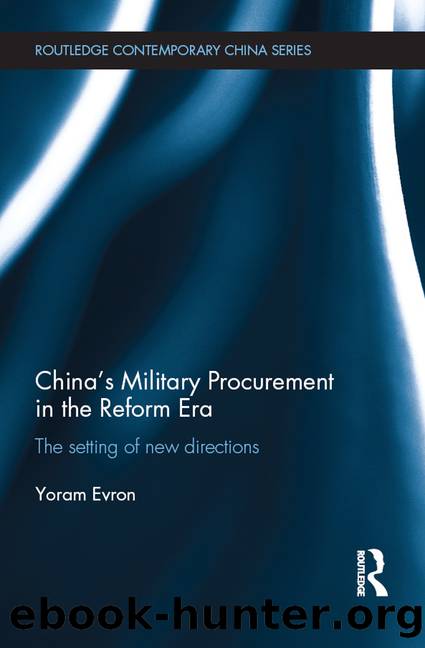China's Military Procurement in the Reform Era: The Setting of New Directions by Yoram Evron

Author:Yoram Evron [Evron, Yoram]
Language: eng
Format: epub
Tags: International Relations, Ethnic Studies, Social Science, Political Science, Regional Studies, General
ISBN: 9781317478942
Google: 7b0BCgAAQBAJ
Publisher: Routledge
Published: 2015-06-26T07:07:01+00:00
Source: China Statistical Yearbook 2011 (2011).
Table 6.2 Defense budget, 1989â94
Sources: China Statistical Yearbook 2011 (2011); SIPRI Yearbook 1999 (1999: 157).
Changes in the military sphere
At this time change occurred in the military sphere as well as the political. This was due to the ending of the Cold War and the outbreak of the Gulf War in 1991. While the Cold War was marked by unprecedented global tension, it had a stabilizing dimension as well: there was clarity as to the identity of the conflicting blocs, the balance of power, the areas of confrontation, and the rules of the game (Gaddis 1987: 221â3). Such was the situation for China also, and although its perception of its security environment fundamentally changed in the 1980s, this mainly concerned the level of threat, not its source or its nature. In the second half of that decade, when Chinese strategists began to focus on limited conflicts along the border, this shift stemmed chiefly from the need to impart relevance and direction to the effort at military modernization, not from the manifestation of an actual new threat.
Chinaâs threat perception changed substantially only with the collapse of the Soviet bloc, when the rise of new strategic deployments necessitated redrawing the national threat map. This was problematic, especially because after the warming of relations with the Soviet Union and before the outbreak of the Gulf War no clear-cut military hazard was apparent on the horizon. The Vietnamese menace was receding, the skirmishes for control of the South China Sea were in abeyance, and fresh potential threats accompanying the new international order â Japan, Russia, and the new republics in Central Asia â were not sufficiently concrete (Segal 1992: 855â63. For explicit expressions see Zhou 1990; Li Qingshan 1990: 1). The most likely military confrontation was with Taiwan: along with Taipeiâs formal statement in 1991 on jettisoning of the idea of unifying China by force, separatist tendencies began to sprout there. This provoked outrage in Beijing, which warned that any attempt to realize the idea would be a casus belli, while Taiwan briskly set about its military modernization, which included the import of advanced Western warfare systems. The climax was its purchase of 150 F-16 aircraft from the US and 60 Mirage 2000 aircraft from France in the early 1990s (Lin 1993: 771â9, 793â9). Still, even this threat was in essence potential. Taiwan adopted a moderate line, and in 1992 indeed initiated an agreement to prohibit hostile acts from either side of the Strait. In any case, the initiative for any military move between the two was primarily in Chinaâs hands. The overall result was that Chinaâs security environment remained as relatively calm as it had been during the previous decade.
Not surprisingly, Beijing was indecisive about how to build its military forces. It was clear to all that advanced technology would fulfill a central role in any future warfare, which would be of a combined three-dimensional nature (Zeng 1989; Liu 1989; Li Dianren 1990: 1â2), but it was not clear how this capability should be constructed.
Download
This site does not store any files on its server. We only index and link to content provided by other sites. Please contact the content providers to delete copyright contents if any and email us, we'll remove relevant links or contents immediately.
What's Done in Darkness by Kayla Perrin(25493)
Shot Through the Heart: DI Grace Fisher 2 by Isabelle Grey(18209)
Shot Through the Heart by Mercy Celeste(18153)
The Fifty Shades Trilogy & Grey by E L James(17768)
The 3rd Cycle of the Betrayed Series Collection: Extremely Controversial Historical Thrillers (Betrayed Series Boxed set) by McCray Carolyn(13182)
The Subtle Art of Not Giving a F*ck by Mark Manson(12898)
Scorched Earth by Nick Kyme(11823)
Stepbrother Stories 2 - 21 Taboo Story Collection (Brother Sister Stepbrother Stepsister Taboo Pseudo Incest Family Virgin Creampie Pregnant Forced Pregnancy Breeding) by Roxi Harding(11019)
Drei Generationen auf dem Jakobsweg by Stein Pia(10211)
Suna by Ziefle Pia(10179)
Scythe by Neal Shusterman(9251)
International Relations from the Global South; Worlds of Difference; First Edition by Arlene B. Tickner & Karen Smith(8600)
Successful Proposal Strategies for Small Businesses: Using Knowledge Management ot Win Govenment, Private Sector, and International Contracts 3rd Edition by Robert Frey(8407)
This is Going to Hurt by Adam Kay(7682)
Dirty Filthy Fix: A Fixed Trilogy Novella by Laurelin Paige(6445)
He Loves Me...KNOT by RC Boldt(5798)
How to Make Love to a Negro Without Getting Tired by Dany LaFerrière(5369)
Interdimensional Brothel by F4U(5299)
Thankful For Her by Alexa Riley(5149)
